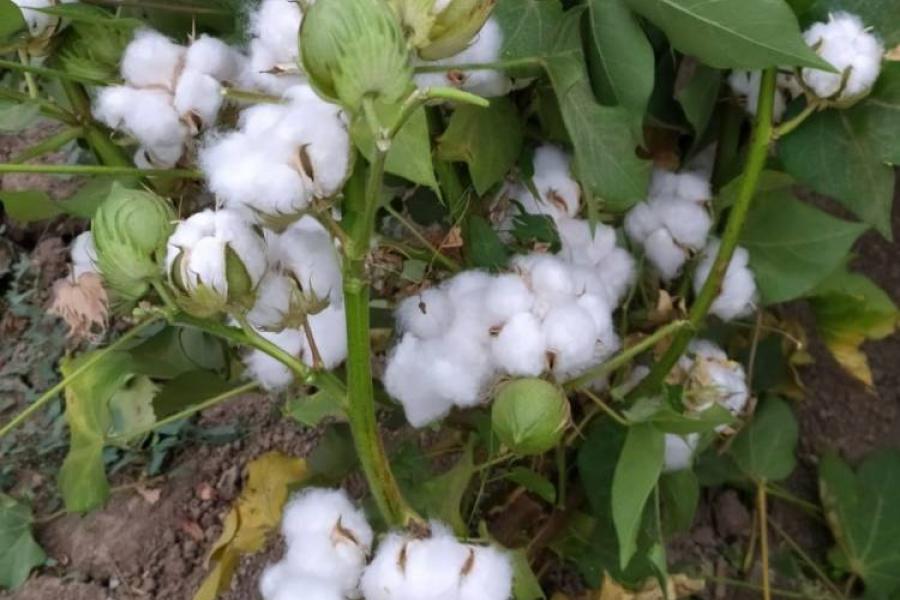Climate-Smart Agriculture Shows Promise in Improving Azerbaijan’s Cotton Productivity

The project outcome shows the significant potential of climate-smart practices in increasing agricultural productivity.
Researchers and farmers in Azerbaijan, implementing climate-smart agricultural practices based on nuclear and related techniques, have been able to more than double their yields of cotton production in a project supported by the IAEA in partnership with the Food and Agriculture Organization of the United Nations (FAO). Through the use of a new variety called “cotton super”, combined with carefully implemented CSA practices which help to understand how to sustainably increase agricultural productivity, the pilot project has seen yields increase from the country’s average of three tonnes per hectare to eight tonnes per hectare.
Implemented in 2021, the pilot, part of an IAEA technical cooperation project, focused on developing climate-smart agricultural guidelines for cotton production, training Azerbaijani researchers and progressive farmers in climate-smart agricultural practices and designing on-farm demonstration trials. A further project, initiated in 2022 and focusing on strengthening best practices in soil, nutrient, and water management agricultural practices for cotton production, aims to help improve cotton productivity, as Azerbaijan’s land is particularly vulnerable to climate change and soil degradation. The country’s average annual temperature has risen by 0.4 degrees Celsius since 1991, with decreasing rainfall and more frequent extreme weather events, such as floods, droughts or heat waves.
“Generally speaking, 60 per cent of improvement in crop productivity comes from capitalising on the strategic application of soil nutrients and water management,” said Mohammad Zaman, a soil scientist at the Joint FAO/IAEA Centre of Nuclear Techniques in Food and Agriculture and Technical Officer of the project. “It’s about the right amount, in the right way, at the right growth stage.”
Climate-smart agricultural practices involve the use of isotopic techniques to obtain essential information on how to optimize fertilizer use and increase the efficiency of agricultural production while maintaining soil health.
“When we started, Azerbaijan’s soils were heavily degraded, the fertility was very poor, and so the soil did not have the capacity to provide all the essential nutrients required for the cotton growth,” Zaman said. To address this, IAEA experts developed a complete package of nuclear and related farming techniques: from preparing soil and selecting the best cotton varieties to applying nutrients and irrigation to cotton fields and ensuring weed, pest and disease control.
“Applying improved soil, nutrient and water management practices along with using 'cotton super' variety has led us to increase our cotton productivity, quality and profit,” said Sakhavat Mammadov, a farmer from Azerbaijan who took part in the pilot project and has been using CSA practices on his farm for the last two years.

Using a stable isotope nitrogen-15, scientists collect quantitative data about how much nitrogen fertilizers cotton needs and how effectively they are taken up by the plant. (Photo: M. Zaman/IAEA)
Nuclear and related techniques help not only in increasing agricultural productivity but also in building resilience of agriculture systems to climate change. In Azerbaijan, the researchers used a technique involving nitrogen-15 (N-15), a stable isotope. Nitrogen plays an important role in plant growth and photosynthesis — the process whereby plants convert carbon dioxide and sunlight into plant food. Zaman explained that a lack of nutrients in the soil, such as nitrogen, leads to low and less nutritious yields. Excessive or incorrect application of nitrogen fertilizers, on the other hand, contributes to emissions of greenhouse gases and pollution of surface and groundwater.
“Cotton in Azerbaijan is expected to be one of the crops experiencing the greatest yield decline due to climate change and rapid soil degradation,” Zaman said. “Taking advantage of isotopic techniques, such as the use of N-15, can help adapt to this situation, making the cotton sector more competitive as well as ensuring employment and improving the welfare of the rural population.”
Azerbaijan has in the past been a leading producer and major exporter of cotton, harvesting more than 830,000 tonnes in the 1980s, which provided up to a quarter of the country’s income. However, the transition to a free market and the rapid growth of other industries in the 1990s contributed to cotton losing its key role in Azerbaijan's economy, with production falling to a record low of 31,000 tonnes in 2009.
The project outcome shows the significant potential of climate-smart practices in increasing agricultural productivity. “Considering the total cotton growing areas of 105,000 hectares in Azerbaijan, a 10 per cent adoption of the IAEA climate-smart agricultural practices would produce 84,000 tonnes of cotton compared to 31,500 tonnes, representing a 166 per cent increase over conventional cotton farming practices,” Zaman said. “Seeing the extraordinary success in applying climate-smart agricultural practices in this project, provides an exciting indication and tremendous promise on how it can help Azerbaijan to increase their cotton production significantly and thus, greatly impact Azerbaijani economy.”
The IAEA, through its technical cooperation programme and through the Joint FAO/IAEA Centre, assists countries in applying climate-smart agricultural methods to increase productivity, adapting agricultural systems to climate change and reducing their impact on the environment. The Joint Centre also supports research in this area. In a coordinated research project focused on the use of climate-smart nuclear solutions to help minimize the farming impacts on climate , scientists from Brazil, Chile, Costa Rica, Iran and Pakistan reported a 50 per cent reduction in greenhouse gases. Other climate-smart agricultural practices are helping to develop balanced diet solutions for livestock amid recurring droughts in Angola; to improve water use and nutrient management on soils in Kenya; and to combat soil erosion in Tunisia.



